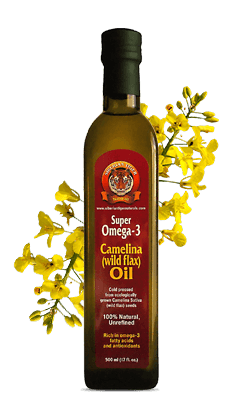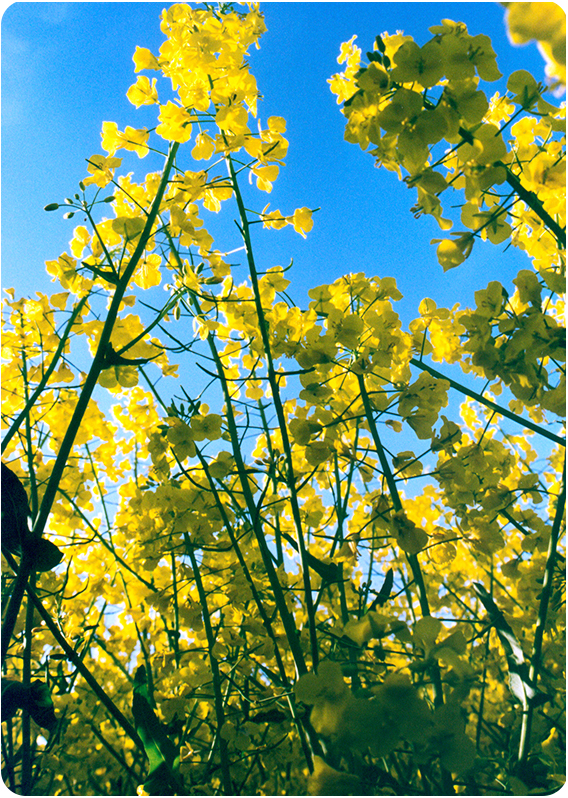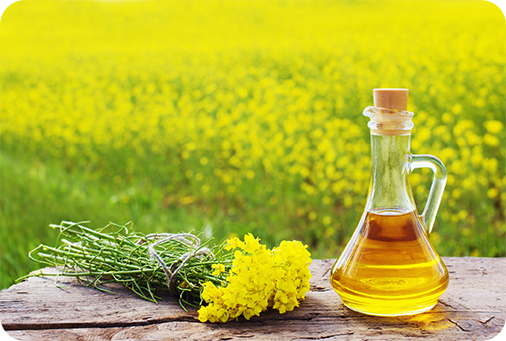Siberian Camelina (Wild Flax) Oil
~
Camelina (Camelina Sativa) - also known as wild flax, German sesame, or Siberian oilseed - is an ancient oleaginous (oil-bearing) plant from the Cruciferae family, which has been domesticated and extensively used in Europe for several thousand years.
Camelina (Camelina Sativa) – also known as wild flax, German sesame, or Siberian oilseed – is an ancient oleaginous (oil-bearing) plant from the Cruciferae family, which has been domesticated and extensively used in Europe for several thousand years. The seed oil of Camelina contains a very generous amount (up to 45 per cent) of omega-3 fatty acids, as well as a potent antioxidant complex making the oil very stable and resistant to heat and rancidity. Unlike any other omega-3 oil, Camelina oil is perfectly suitable for use not only as a well-balanced omega-3 supplement, but also as a health-promoting everyday cooking oil. Combined with a delicious nutty flavor, this extraordinary blend of beneficial polyunsaturated fatty acids and high oxidative stability makes Camelina oil an excellent, versatile overall source of both omega-3 fats and powerful antioxidants, including tocopherols, carotenoids, and phosphatides. Known as “wild flax” because it is often found growing together with common flax, Camelina, while supplying almost as many omega-3 fatty acids as common flax, is much more stable than the latter, and also tastes much better. This is why we call it “The Stable Flax”.

17 oz. (500 ml)
$22.95
 Omega-3 fatty acids are in the spotlight of today’s natural and holistic approaches to human health. These healthy essential fats have been almost entirely forced out of the everyday American diet by the commercialization of our food supply by the food processing industry. Therefore, adding a certain amount of omega-3 fatty acids to one’s diet is believed to be a good way of achieving and maintaining health and wellness. The question of what constitutes the best source of omega-3 supplementation is, however, still being widely debated by scientists, doctors and consumers alike.
Omega-3 fatty acids are in the spotlight of today’s natural and holistic approaches to human health. These healthy essential fats have been almost entirely forced out of the everyday American diet by the commercialization of our food supply by the food processing industry. Therefore, adding a certain amount of omega-3 fatty acids to one’s diet is believed to be a good way of achieving and maintaining health and wellness. The question of what constitutes the best source of omega-3 supplementation is, however, still being widely debated by scientists, doctors and consumers alike.  Omega-3 fatty acids are in the spotlight of today’s natural and holistic approaches to human health. These healthy essential fats have been almost entirely forced out of the everyday American diet by the commercialization of our food supply by the food processing industry. Therefore, adding a certain amount of omega-3 fatty acids to one’s diet is believed to be a good way of achieving and maintaining health and wellness. The question of what constitutes the best source of omega-3 supplementation is, however, still being widely debated by scientists, doctors and consumers alike.
Omega-3 fatty acids are in the spotlight of today’s natural and holistic approaches to human health. These healthy essential fats have been almost entirely forced out of the everyday American diet by the commercialization of our food supply by the food processing industry. Therefore, adding a certain amount of omega-3 fatty acids to one’s diet is believed to be a good way of achieving and maintaining health and wellness. The question of what constitutes the best source of omega-3 supplementation is, however, still being widely debated by scientists, doctors and consumers alike.  Omega-3 fatty acids are in the spotlight of today’s natural and holistic approaches to human health. These healthy essential fats have been almost entirely forced out of the everyday American diet by the commercialization of our food supply by the food processing industry. Therefore, adding a certain amount of omega-3 fatty acids to one’s diet is believed to be a good way of achieving and maintaining health and wellness. The question of what constitutes the best source of omega-3 supplementation is, however, still being widely debated by scientists, doctors and consumers alike.
Omega-3 fatty acids are in the spotlight of today’s natural and holistic approaches to human health. These healthy essential fats have been almost entirely forced out of the everyday American diet by the commercialization of our food supply by the food processing industry. Therefore, adding a certain amount of omega-3 fatty acids to one’s diet is believed to be a good way of achieving and maintaining health and wellness. The question of what constitutes the best source of omega-3 supplementation is, however, still being widely debated by scientists, doctors and consumers alike. Solution: Camelina (Wild Flax) Oil:
The Stable Flax
Solution: Camelina (Wild Flax) Oil: The Stable Flax
~
 Considering the above, one inevitably comes to a conclusion that none of the commercially available sources of omega-3 fatty acids are fully satisfactory and completely problem-free. While it is possible to achieve the required level of omega-3 supplementation using either fish and fish-derived products, or flax oil, it would be highly desirable to have an omega-3-rich oil that would also be more resistant to oxidation and free of toxic contaminants. The good news is that such an oil does, indeed, exist. This is the oil of Camelina – The Stable Flax!
From the times of the Roman Empire to the Second World War, Camelina seed oil was a common edible oil all over Europe, and especially in Germany, Scandinavia, and Russia. In Russia, it was much preferred to regular flax oil because of its better taste and higher stability, and commanded a significantly higher market price.
Nowadays we are witnessing a growing interest in Camelina and its excellent seed oil which was able to withstand the test of time. In addition to Russia, where Camelina never ceased to be an important source of cooking oil, extensive research of this unique healing plant is underway in the countries of the European Union, as well as in Canada and the United States.
Camelina seeds produce a golden-colored oil with a delicate, almond-like flavor, containing up to 45 percent of omega-3 alpha-linolenic acid (ALA). The fatty acid composition of Camelina oil is also unique and very beneficial in terms of its qualities. While being a rich source of ALA, the oil is highly monounsaturated, naturally supplying more than 30 percent of stable monounsaturated (oleic and gadoleic) fatty acids. This significant proportion of monounsaturates (monounsaturated olive oil forms the basis of the healthy Mediterranean diet) further enhances the oxidative stability of Camelina oil, and makes it a more versatile cooking oil.
Considering the above, one inevitably comes to a conclusion that none of the commercially available sources of omega-3 fatty acids are fully satisfactory and completely problem-free. While it is possible to achieve the required level of omega-3 supplementation using either fish and fish-derived products, or flax oil, it would be highly desirable to have an omega-3-rich oil that would also be more resistant to oxidation and free of toxic contaminants. The good news is that such an oil does, indeed, exist. This is the oil of Camelina – The Stable Flax!
From the times of the Roman Empire to the Second World War, Camelina seed oil was a common edible oil all over Europe, and especially in Germany, Scandinavia, and Russia. In Russia, it was much preferred to regular flax oil because of its better taste and higher stability, and commanded a significantly higher market price.
Nowadays we are witnessing a growing interest in Camelina and its excellent seed oil which was able to withstand the test of time. In addition to Russia, where Camelina never ceased to be an important source of cooking oil, extensive research of this unique healing plant is underway in the countries of the European Union, as well as in Canada and the United States.
Camelina seeds produce a golden-colored oil with a delicate, almond-like flavor, containing up to 45 percent of omega-3 alpha-linolenic acid (ALA). The fatty acid composition of Camelina oil is also unique and very beneficial in terms of its qualities. While being a rich source of ALA, the oil is highly monounsaturated, naturally supplying more than 30 percent of stable monounsaturated (oleic and gadoleic) fatty acids. This significant proportion of monounsaturates (monounsaturated olive oil forms the basis of the healthy Mediterranean diet) further enhances the oxidative stability of Camelina oil, and makes it a more versatile cooking oil.  Considering the above, one inevitably comes to a conclusion that none of the commercially available sources of omega-3 fatty acids are fully satisfactory and completely problem-free. While it is possible to achieve the required level of omega-3 supplementation using either fish and fish-derived products, or flax oil, it would be highly desirable to have an omega-3-rich oil that would also be more resistant to oxidation and free of toxic contaminants. The good news is that such an oil does, indeed, exist. This is the oil of Camelina – The Stable Flax!
Considering the above, one inevitably comes to a conclusion that none of the commercially available sources of omega-3 fatty acids are fully satisfactory and completely problem-free. While it is possible to achieve the required level of omega-3 supplementation using either fish and fish-derived products, or flax oil, it would be highly desirable to have an omega-3-rich oil that would also be more resistant to oxidation and free of toxic contaminants. The good news is that such an oil does, indeed, exist. This is the oil of Camelina – The Stable Flax!
From the times of the Roman Empire to the Second World War, Camelina seed oil was a common edible oil all over Europe, and especially in Germany, Scandinavia, and Russia. In Russia, it was much preferred to regular flax oil because of its better taste and higher stability, and commanded a significantly higher market price.
Nowadays we are witnessing a growing interest in Camelina and its excellent seed oil which was able to withstand the test of time. In addition to Russia, where Camelina never ceased to be an important source of cooking oil, extensive research of this unique healing plant is underway in the countries of the European Union, as well as in Canada and the United States.
Camelina seeds produce a golden-colored oil with a delicate, almond-like flavor, containing up to 45 percent of omega-3 alpha-linolenic acid (ALA). The fatty acid composition of Camelina oil is also unique and very beneficial in terms of its qualities. While being a rich source of ALA, the oil is highly monounsaturated, naturally supplying more than 30 percent of stable monounsaturated (oleic and gadoleic) fatty acids. This significant proportion of monounsaturates (monounsaturated olive oil forms the basis of the healthy Mediterranean diet) further enhances the oxidative stability of Camelina oil, and makes it a more versatile cooking oil.
 Considering the above, one inevitably comes to a conclusion that none of the commercially available sources of omega-3 fatty acids are fully satisfactory and completely problem-free. While it is possible to achieve the required level of omega-3 supplementation using either fish and fish-derived products, or flax oil, it would be highly desirable to have an omega-3-rich oil that would also be more resistant to oxidation and free of toxic contaminants. The good news is that such an oil does, indeed, exist. This is the oil of Camelina – The Stable Flax!
Considering the above, one inevitably comes to a conclusion that none of the commercially available sources of omega-3 fatty acids are fully satisfactory and completely problem-free. While it is possible to achieve the required level of omega-3 supplementation using either fish and fish-derived products, or flax oil, it would be highly desirable to have an omega-3-rich oil that would also be more resistant to oxidation and free of toxic contaminants. The good news is that such an oil does, indeed, exist. This is the oil of Camelina – The Stable Flax!
From the times of the Roman Empire to the Second World War, Camelina seed oil was a common edible oil all over Europe, and especially in Germany, Scandinavia, and Russia. In Russia, it was much preferred to regular flax oil because of its better taste and higher stability, and commanded a significantly higher market price.
Nowadays we are witnessing a growing interest in Camelina and its excellent seed oil which was able to withstand the test of time. In addition to Russia, where Camelina never ceased to be an important source of cooking oil, extensive research of this unique healing plant is underway in the countries of the European Union, as well as in Canada and the United States.
Camelina seeds produce a golden-colored oil with a delicate, almond-like flavor, containing up to 45 percent of omega-3 alpha-linolenic acid (ALA).
The fatty acid composition of Camelina oil is also unique and very beneficial in terms of its qualities. While being a rich source of ALA, the oil is highly monounsaturated, naturally supplying more than 30 percent of stable monounsaturated (oleic and gadoleic) fatty acids. This significant proportion of monounsaturates (monounsaturated olive oil forms the basis of the healthy Mediterranean diet) further enhances the oxidative stability of Camelina oil, and makes it a more versatile cooking oil.

Last, but not least, Siberian Camelina oil is relatively low in omega-6 linoleic acid, resulting in a favorable omega-3/omega-6 ratio of up to 3-to-1. This is also a very important benefit, since our diets today are usually oversaturated with omega-6 fatty acids and deficient in omega-3s, resulting in a harmful fatty acid imbalance which may have far-reaching negative consequences for health.
The combination of these important advantages makes Siberian Camelina oil one of the most balanced and desirable sources of omega-3 fatty acids. While being almost as abundant in beneficial omega-3s as regular flax oil and fish oil, it is highly stable and rich in vitamin E and other natural antioxidants, as well as healthy monounsaturated fatty acids.
 Last, but not least, Siberian Camelina oil is relatively low in omega-6 linoleic acid, resulting in a favorable omega-3/omega-6 ratio of up to 3-to-1. This is also a very important benefit, since our diets today are usually oversaturated with omega-6 fatty acids and deficient in omega-3s, resulting in a harmful fatty acid imbalance which may have far-reaching negative consequences for health. The combination of these important advantages makes Siberian Camelina oil one of the most balanced and desirable sources of omega-3 fatty acids. While being almost as abundant in beneficial omega-3s as regular flax oil and fish oil, it is highly stable and rich in vitamin E and other natural antioxidants, as well as healthy monounsaturated fatty acids.
Last, but not least, Siberian Camelina oil is relatively low in omega-6 linoleic acid, resulting in a favorable omega-3/omega-6 ratio of up to 3-to-1. This is also a very important benefit, since our diets today are usually oversaturated with omega-6 fatty acids and deficient in omega-3s, resulting in a harmful fatty acid imbalance which may have far-reaching negative consequences for health. The combination of these important advantages makes Siberian Camelina oil one of the most balanced and desirable sources of omega-3 fatty acids. While being almost as abundant in beneficial omega-3s as regular flax oil and fish oil, it is highly stable and rich in vitamin E and other natural antioxidants, as well as healthy monounsaturated fatty acids.  Last, but not least, Siberian Camelina oil is relatively low in omega-6 linoleic acid, resulting in a favorable omega-3/omega-6 ratio of up to 3-to-1. This is also a very important benefit, since our diets today are usually oversaturated with omega-6 fatty acids and deficient in omega-3s, resulting in a harmful fatty acid imbalance which may have far-reaching negative consequences for health.
Last, but not least, Siberian Camelina oil is relatively low in omega-6 linoleic acid, resulting in a favorable omega-3/omega-6 ratio of up to 3-to-1. This is also a very important benefit, since our diets today are usually oversaturated with omega-6 fatty acids and deficient in omega-3s, resulting in a harmful fatty acid imbalance which may have far-reaching negative consequences for health.
The combination of these important advantages makes Siberian Camelina oil one of the most balanced and desirable sources of omega-3 fatty acids. While being almost as abundant in beneficial omega-3s as regular flax oil and fish oil, it is highly stable and rich in vitamin E and other natural antioxidants, as well as healthy monounsaturated fatty acids.
The delicate, pleasant taste and aroma of Siberian Camelina oil make it an excellent salad and cooking oil. On our recipes page, you will find many creative ways of using Camelina oil in your kitchen. When taken straight, the recommended dosage is one tablespoon (15 ml) daily, taken at any time.
To place an order for our Siberian Camelina (wild flax) oil, please go to our Order Page. If you want more information or have additional questions, please send an e-mail to our holistic nutritionists at [email protected]

